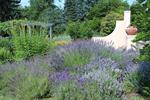Get Serious about Growing, Harvesting & Using Lavender
Commercially lavender is grown in France, England, Spain, Italy, USA, Australia, South Africa, New Zealand and Japan. Each region growing species that are best suited to local conditions – many trials have been conducted world-wide to isolate the best species for specific local conditions.
COURSE STRUCTURE
The course is divided into ten lessons as follows:
- Introduction: Classification and identification of lavender, general characteristics of the group, contacts (ie: nurseries, seed, clubs, etc.)
- Soils, Fertilisers and Nutrition for Lavender: Soil structure, pH, organic matter, ameliorants and organic growing.
- Cultural Techniques for Lavender Growing: Pruning, water management (mulching, irrigation, drainage, etc.), planting and establishment methods, crop scheduling, no dig gardening.
- Lavender Propagation: Propagation from cuttings, propagation growth media, other propagation methods,
- Commercial Alternatives: Managing a Market Garden, standards, mulches, problems and their control, weed control without chemicals, economic outlook for herbs.
- Plant Variety Selection and Breeding: Breeding and selecting new varieties, lavender clone selection for essential oils in Tasmania.
- Building Plant Knowledge: Lavender types and other varieties, advantages and disadvantages of different varieties.
- Harvesting, Post harvest Treatment and Storage: Harvesting, distillation and oils, post harvest preservation of fresh herbs, drying lavender.
- Processing and Making Lavender Products: Lavender crafts, using herbs in cooking, selling herb products.
- Marketing Lavender Produce: how to market your produce, considering your market, market research, selling successfully.
AIMS
- Describe the plant naming system and classification of plants
- Discuss the nature and scope of the Lavender genus.
- Describe the nutritional requirements of the lavender species.
- Explain the cultural requirements of the lavender species.
- Explain propagating techniques specific to lavender
- Describe commercial lavender growing operations.
- Select species appropriate to the climatic and soil conditions of a chosen locality.
- Describe of a variety of lavender species and cultivars.
- Describe the production processes on a lavender farm.
- Describe various lavender products and discuss the way in which they are processed.
- Explain the processes used in the marketing of lavender products
 Growing High Quality Lavender can be More Involved than you Might Think!
Growing High Quality Lavender can be More Involved than you Might Think!
Lavender can be easy to grow, in the right climate; but achieving a high quality lavender crop, may be far more involved. There are many different types of lavenders; and they do vary in their cultural requirements; and their ability to produce flowers (both quality and quantity).
Lavenders belong to the same plant family as mint, thyme, rosemary and many other herbs and shrubs (i.e.. Lamiaceae, formerly called Labiateae).
The common name is lavender (spelled with “e”), and the scientific (genus) name is Lavandula (spelled with an “a”)
Experts vary on how many species of Lavandula exist. Some authorities suggest around 20 species, and others as many as 40 species. A number of authorities agree on 28 as the number of species.
There are also hundreds, if not thousands of varieties (genotypes).
 Flower Quality
Flower Quality
Considerations can be:
- How attractive are the flowers
- Are the flowers marked, damaged or blemished (eg. Containing insects, partially eaten, marked by disease –eg caused by moisture
How pure is lavender oil. Some flowers contain more “camphor oil” than others. If there is virtually no camphor oil, the oils can be much more valuable for the perfume industry.
Flower Quantity
Factors that need considering are:
- How many flowers does the plant produce
- How big are the flower heads produced
- How long are the flower stalks
- How many weeks of the year does the plant have flowers.
The nature and quality of lavender oil can be extremely variable from farm to farm and region to region. Large scale lavender farms, usually producing over 500 kg of oil (or more) annually, are most likely going to be selling their produce internationally. When product is sold internationally; the International standards association’s standard for “Essential Oil Nomenclature” should be adhered to. Smaller scale production (sometimes referred to as “cottage production”) that is only trading domestically, may not need to follow the same standards for labelling product.
Even domestic oils should not be misrepresented by labelling. Any responsible grower should indicate the species (or cultivar) which the oil is derived from, and the region in which it is grown.
Unless the chemistry of an oil is known and understood properly, it is best to only sell in child- proof containers, and label bottles with a warning against ingesting the oil.